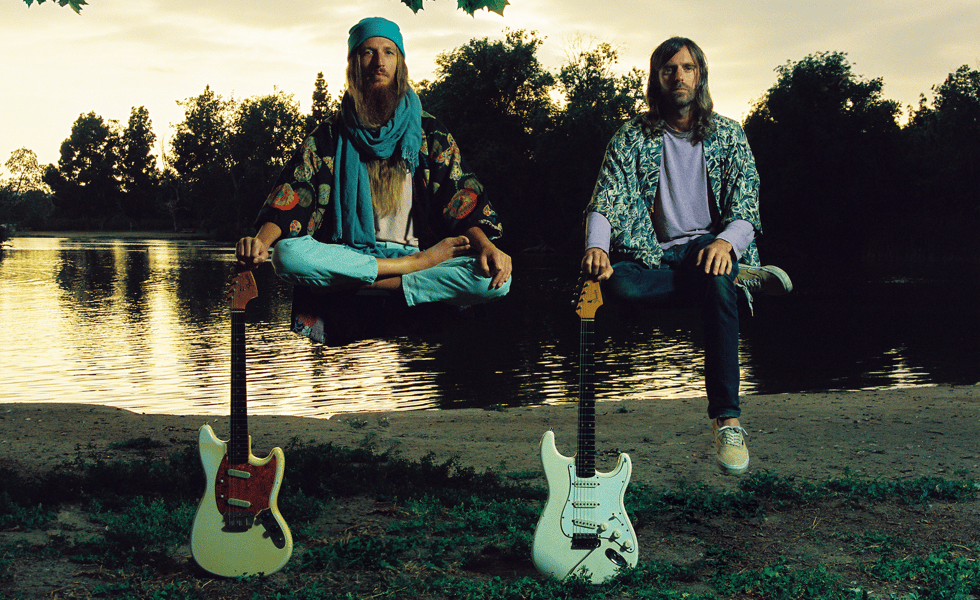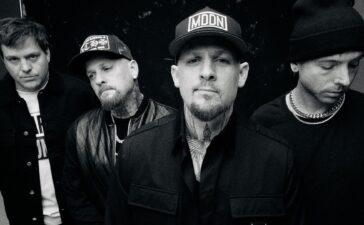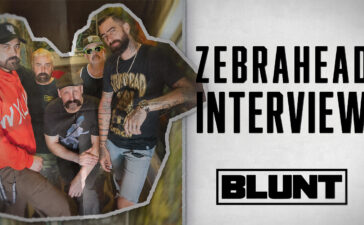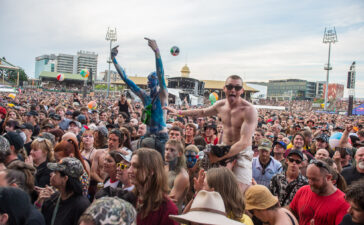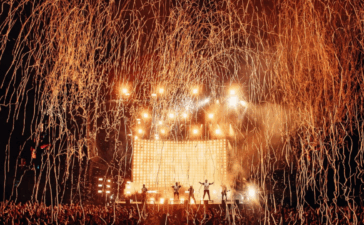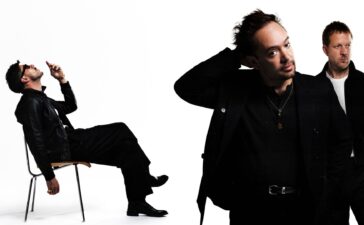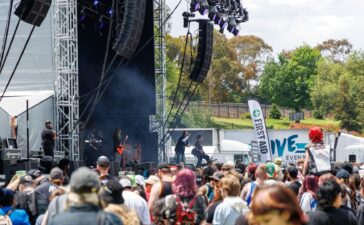In the year 2021, when there are hundreds of thousands of artists all tinkering away at some variation of pop melodies with six strings at their disposal, the idea that any guitarist could have a “signature sound” – a palette of tones unique only to that one creative mind – is a little obnoxious.
And yet, when you hear Mike Stroud play one of his signature bendy, pseudo-synth-y licks, you know it’s his immediately. Obviously you can hear it in abundance on any of Ratatat’s four albums (the most recent of which being 2015’s magical Magnifique), but you can also hear it on a couple tracks of Kid Cudi’s 2010 debut, Man On The Moon: The End Of Day. You can hear it on the CSS track ‘Red Alert’, and on Despot’s ‘Look Alive’. And now, years after Ratatat slipped into their premature hiatus – Stroud tells BLUNT that the duo, rounded out by Evan Mast, have no current plans to reconvene – you can hear it in all the nooks and crannies of Stroud’s latest project, Kunzite.
A collaborative effort with Agustin White (of Abuela and White Flight, among other various bits and pieces), Kunzite shine brightly with a mix of gauzy, intoxicating psych-rock, fuzzed-out dance pop and, of course, the buzzy, groove-inflected pomp of Stroud’s own one-of-a-kind style. The duo made their debut in 2018 with the transcendental full-length Birds Don’t Fly, a shimmering journey through the peaks and valleys of a hazy year spent throwing ideas back and forth over email. This year, they’ve followed it up with Visuals – an evolution to the Kunzite formula both sonically and tangibly, as it marked the pair’s first in-studio collaborations.
On the concept behind Visuals, the band explain: “We’ve found, as musicians, we’re creating soundscapes that can sometimes trigger visions in the listener, and we’ve always been interested in that very phenomena itself — how music can induce visual experiences in the mind’s eye. Listening to the Visuals album in sequence, many of the songs start to blend into each other as the album progresses, making for a journey that might pair well with your favourite psychedelic substance of choice.”
We caught up with Stroud and White to learn more about how this mind-bending beauty came to life.
As the follow-up to Birds Don’t Fly, how did you want Visuals to take Kunzite to to the next level?
Mike: I think we were trying to make this album more of a cohesive psychedelic listening experience. Birds Don’t Fly was essentially a collage of all the songs we had emailed back and forth at the beginning of our collaboration. The writing process for Visuals spanned a few years but we always had it in mind to make it flow more seamlessly together and really tell a story. We really tried to step up the drums and percussion on this album too, adding more layers of live organic drums into the mix. Birds was mostly simple programmed beats.
I don’t really remember writing the songs all that well, to be honest, so the experiences of making these two different albums kind of blend together for me. We had probably already written and recorded a few of [the songs] before Birds was even released.
What stayed the same with the recording process, and what changed?
Mike: We still emailed a lot of these songs back and forth – at least in their embryonic phases – but much more time was spent physically together in our respective studios in New York and Hawaii. ‘Waimalien’, ‘PLN’, ‘Frosty’, ‘Cielo’ and ‘Novas’ were all made together from scratch, but the rest were started by either of us and emailed back and forth with finishing touches added together in my studio.
One major difference with this album is that on a lot of these songs, we brought in extra help for the mixing process. ‘Novas’ was mixed by a friend and collaborator/synth player in our live band, Jules De Gasperis. ‘Jupiter’, ‘Saturn’, ‘Halohead’, ‘Frosty’, ‘Cielo’, ‘Whistles’ and ‘Azurite’ were all mixed through a vintage Neve board at Outlier Inn in upstate New York, by Josh Druckman. That brought so much extra warmth and depth to those tracks, which I felt was missing on Birds.
How does your creative process with Kunzite differ from Ratatat?
Mike: There’s a lot less pressure and tension involved in Kunzite’s creative process. I’m proud of those Ratatat albums, but the vibe in the studio was often pretty intense, and we butted heads a lot. Without going too in-depth, I’ll say that I feel a lot more freed up to do whatever I want with Kunzite. I was very precious about every idea in Ratatat and took it too seriously a lot of the time. I feel much more playful and light when I make Kunzite songs with Agustin.
Does it always start with one of you coming up with an idea and the other adding to it, or can inspiration strike anywhere?
Mike: The process is always a little different from song to song. I started the basic music for ‘Lemon Swayze’ in my studio and sent it on to Agustin to sing over. The lyrics he came back with were originally meant to be a joke, but we decided to keep them and just make it a fun summer song.
‘Halohead’ was written and recorded by Agustin all the way back in 2015! That’s actually the song that sparked Kunzite into existence. We became friends in 2001, but then hadn’t seen each other for like ten years or so. He sent me that song and then we hung out at Coachella 2015 and played each other a ton of music. Over the course of the night, we continued to get more and more excited about collaborating together, and that’s when we first started emailing songs back and forth.
Somewhere in the making of Visuals I came across that song again and decided to add a bunch of guitars and produce it out a bit more. I believe that song was sparked by a psychedelic mushroom experience Agustin had. He can chime in here.
Agustin: Yeah, I had one of those mushroom experiences where you sort of get blown out of your body and download the entire history of everything, and the only way I could really integrate the experience was to make ‘Halohead’. During the experience, I saw the whole of both the psychic and biological destruction wreaked by the military and banking complexes on our home planet. The totality of it was so overwhelming and repulsive that I had to channel the anger I felt into something that captured the energy, and ideally transmuted it into a ‘declaration of freedom’ of sorts, from these historical institutions that have an insatiable hunger for control. No big deal [laughs].
“It can be a profound experience when listening to music triggers an ‘inner vision’, and I think it’s fascinating that some albums have found almost universal appeal for this sort of thing. “
In the press release, you noted that your goal with Visuals was to create “an album that can be enjoyed both on the dance floor, and within a sensory deprivation tank”. How exactly did you go about channeling those contrasting moods onto the record? What’s the method to the madness when it comes to making something simultaneously chilled-out and energetic?
Agustin: Well, all of that really just happens without any forethought, in the sense we can’t help but lean into more dancey rhythms, if for no other reason than they are often the most fun types of songs to make – the kind that get you dancing, and maybe even laughing, in the studio. But for that song to stick around long enough to actually go onto an album, it’s inevitably going to need to be full of sounds that engages us at a mental level – sounds that are “weird or alien enough” that sort of create mini-psychedelic moments in the mind and/or body of the listener. So if the album can be enjoyed while laying down in a dark room, too, I feel like my mission was accomplished.
There’s also this quote that stands out to me: “We’ve found, as musicians, we’re creating soundscapes that can sometimes trigger visions in the listener, and we’ve always been interested in that very phenomena itself – how music can induce visual experiences in the mind’s eye.” What is some of the imagery that you wanted to invoke with the songs on this album?
Agustin: I can’t think of any specific images we are trying to trigger. But certainly any visions that are ‘hyper-colourful’ or ‘hyper-real’ are the ones that are most significant in my opinion. It can be a profound experience when listening to music triggers an ‘inner vision’, and I think it’s fascinating that some albums have found almost universal appeal for this sort of thing. Take The Dark Side Of The Moon, which is such an obvious example – one of my first memories in life is listening to the second song of that album at two or three years-old, having learned how to operate my dad’s turntable. I would listen to that song over and over again – the track with all the wildly-modulating synthesisers.
This album obviously has a lot of that classic Mike Stroud Guitar Sound™ – those pseudo-psychedelic, groove-driven bends that sound simultaneously silky and screamy. The first word that comes to mind when I think about it is ‘tangy’. I don’t even know why. But how did you develop that?
Mike: Whoa, tangy? Haven’t heard that one before [laughs]. I guess that tone started during the making of the first Ratatat album, and just evolved from there. We were recording all the guitars direct with a Rat pedal, and I discovered that if I rolled out all my tone on the neck pickup of my Epiphone Wilshire, it sounded like a synthesiser. I started collecting as many cool fuzz pedals I could find to try and keep the same style, but spice it up from album to album.
I don’t know, sometimes I think I’m repeating myself too much, but I guess it feels nice to have a “signature” sound. The style of stacking harmonies and writing melodies and counterpart is all from my classical guitar studies in college, where I studied Bach and played in a guitar quartet. To me, it just sounds cooler playing that way with a fuzz pedal than a nylon-string and a footstool [laughs].
Can you let us in on some of your tonal secrets, gear-wise?
Mike: The guitar I use is a 1965 Epiphone Wilshire with mini humbuckers. A lot of the guitar tone just comes from plugging this guitar directly into a good amp. The pickups just sound so good. A pedal that is featured on almost every track on this album is the vintage Univox SuperFuzz pedal, an old germanium fuzz pedal that sounds almost like it’s about to break. That pedal adds all these incredible frequencies to the tone that give it a super psychedelic sound. We use Coil Audio preamps that add a cool vintage vibe to everything, and run everything through a secret compressor – sorry for that. The flutes you hear all over the record are all quena flutes played by Agustin.
Do you find it important to keep experimenting with your style and stretch the boundaries of what you can do with it?
Mike: It’s just about keeping yourself interested in the studio. If you’re making something and you’re already feeling bored by it, you can’t expect anyone else to find it exciting.
What does the future look like for Ratatat?
Mike: No plans yet. My main focus now is Kunzite.
>> KEEP READING: In retrospect: Panic! At The Disco’s ‘A Fever You Can’t Sweat Out’ <<
Visuals is out now via Lowly / Wilder
Click here to get amongst it


